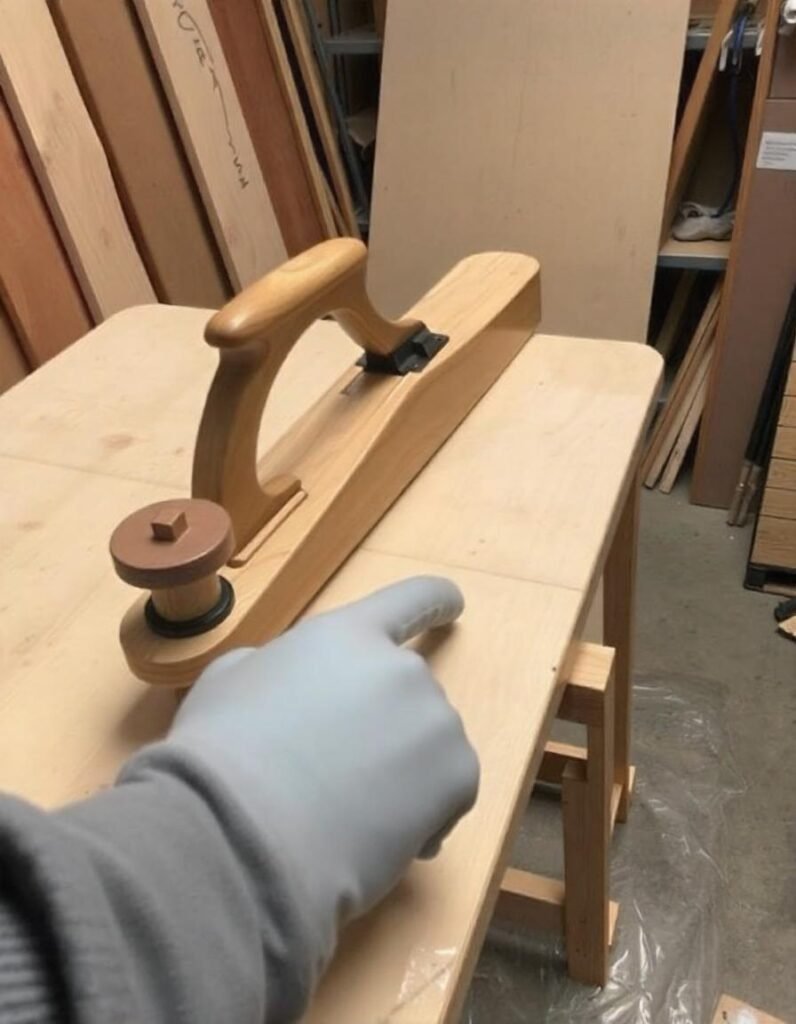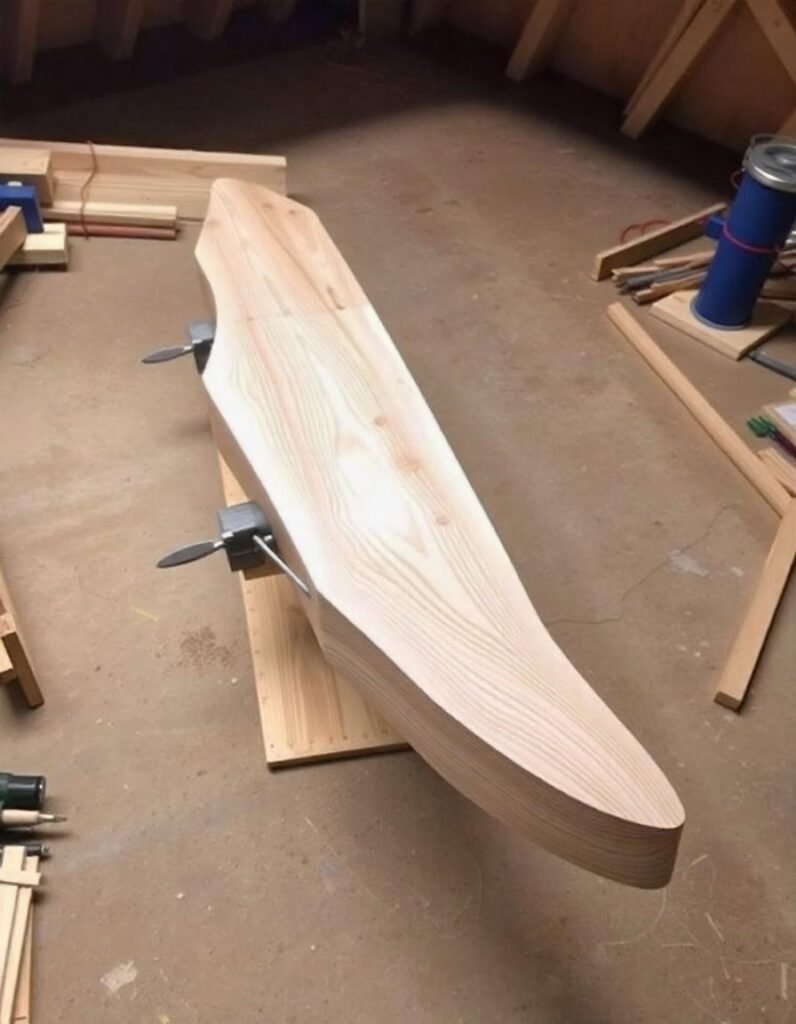Ready to Master Woodworking? Claim Your Free Guide!

Few woodworking tool are as basic or versatile in application as the plane. This most
primal and powerful of tools has been the mainstay of woodworkers since early history and
has never lost any preeminence in its role for shaving off extra wood with grace and
accuracy. From young apprentice to seasoned pro, getting good at working a plane drives
your creations to a whole new plane of existence.
What’s an aeroplane?
A plane is a woodworking tool designed to take off thin, shallow shavings of wood material
from the surface and, as such, create shape and smoothness. The plane consists of an
ordinary-looking body, usually made of wood or metal, that gets fitted with a blade projecting
from the underside. The bottom side is meant to project the blade out when the plane is
pushed through the wooden workpiece to leave a smooth and even finish.
Origins of the Plane
The history of the plane is very rich; in fact, its very origins may be traced back thousands of
years. Many ancient civilizations—the Egyptians, Greeks, and Romans—all used primitive
forms in their woodworking endeavors. Over time, design and functionality evolved in the
plane from information and ideas introduced through different cultures and craftsmen.
It was during the Middle Ages that more developed versions of the plane began in Europe,
having adjustment capabilities for blades and designing for a more ergonomic approach to
woodworking design. By the time of the 18th and 19th centuries, the plane had already been
somewhat classified into types and sizes to perform the intended applications more
efficiently.
Ready to Master Woodworking? Claim Your Free Guide!
Types of planes
Although the plane is fundamentally the same as it is, there are many versions of it to suit
the different needs of woodworking. Following are some of the most common:
- Bench planes: sort of the workhorse of the woodworking world; general smoothing and
flattening can be done with these. They come in such a range of sizes, from ones that are
quite small, almost toy-like, and very manoeuvrable, right up to what are called block planes
at one end—almost the size of an Altoids tin—to the larger jointer and smoothing planes at
the other. - By the name itself, it is clear what the planes are meant for. The rabbet planes are used in
the making of rabbets, which are a type of edge or groove set in along the side of a board.
They are of immense use in forming joints and fitting pieces. - Shoulder Planes: These planes are particularly used on the tenons’ shoulder part for a
clean, precise, perfecting joinery on wood. - Spoke shave Planes: Planes with a curved sole are the small blades that smooth curved
surfaces, mainly on chair legs or spindles. - Scrub Planes: If you want to work fast at taking away a lot of waste wood, the scrub plane
is the plane for you. Fast and for roughing out stock or flattening out rough surfaces, the
thick blade and aggressive cutting angle are ideal.
How to Use a Plane
Though the principle of the plane is simple, one does actually have to invest a bit of a
learning curve, and it must take practice to learn to use one effectively. Below are some tips
that could be useful when trying to get the best out of your plane:
- Sharpen the Blade: Perhaps one of the most basic points to getting the planing at least
smooth and efficient is a really sharp blade. Buy a good sharpening system and learn the
secret of how to hone your plane blade to a razor edge. - Setting the Depth of Cut Most planes have mechanisms, one way or another, to adjust for
greater or lesser depth of cut, that is, how far the blade protrudes from the bed or sole of the
plane. The setting will determine how much is cut with one pass of the plane. Start with a
very small depth and then gradually increase it. - Grain Direction: Take into account the grain direction, making most of your plan run in the
direction of the grain, since you get both a good cut and a better finish at the surface with the
change from the edge grain to the face grain shown. - Motion in Planning: Follow with a consistent and steady planning motion that has equal
pressure and an even angle during each stroke. Don’t rock the tool or apply pressure
unequally, for it makes an uneven surface or results in tear-out. - Maintenance: A plane that has been properly maintained should ensure its best
performance. Keep the body and sole free from all debris, and continue lubricating all
moving parts in order to avoid binding and sticking.
Advantages of Plane
Undoubtedly, there is a different stamp in the woodworking world today from that left by the
early use of power tools. There are several very good arguments, however, why this use of
the humble plane is still quite necessary:
- Precision and Control: The plane permits control in dimensioning the depth of cut and
scale of removal of the wood that is hard to establish with power tools, particularly on light or
detailed work. - Quiet Operation: The plane being silent shall not in any way serve to form a barrier to
working in environments that are shared by others, especially in no-noise environments. - No Dust or Debris: Contrary to power tools that raise hell lots of dust and debris in their
wake, the plane creates a very small quantum of it, therefore much cleaner and safer
working conditions. - Portability: Planes are comparably lightweight and less bulky; thus, a woodsman can
easily transport them from one site to another, anywhere between the workshop and job site. - There is something rather satisfying, almost sneaky, about using a properly sharpened
and tuned plane. And many folks enjoy the tactile experience of putting a ‘touch’ on a piece
of wood. It can be an enriching experience to shape wood by hand.
Plan and Your Projects
Planes are very versatile in woodworking, right from the making of furniture and cabinetry to
handicraft articles and musical instruments. Here is how you can use a plane in your project:
- Smoothing and Flattening a Surface: When preparing a table top, a door panel, or just the
surface of a workbench, a smoothing plane would be an essential tool in your arsenal. - Joints: The rabbet and shoulder planes are indispensable for forming perfectly square,
tight joints, as of necessity in cabinetry, furniture, and larger woodworking projects that call
for tolerances. - Shaping and Contouring: Spoke shave planes with their curved soles put to rest the
tension associated with shaping and contouring curved surfaces. They are indispensable to
work on projects like chair legs, spindles, and turned parts. - Roughing Out Stock Many times, before getting down to the real nitty-gritty of a project,
you’ll need to remove a lot of stock and rough out the stock to dimensions that are close
enough. A scrub plane is just the tool for this job; it enables you to quickly and effectively
remove waste. - Adding Decorative Details: Planes can add decorative details and embellishments to any
of your woodworking projects. Any time you need to add inlay, do some detailing work, or
even do some decorative carving, the control that a plane can give is unparalleled and can
often take your work to artistic heights previously unimaginable.
Take Care of Your Plane
With any high-performance tool, a bit of care and maintenance will go a long way towards
preserving performance and making sure your plane has a long, useful life. The following are
tips on the care of your plane:
- Cleaning: Clean the body, sole, and cutting iron appropriately after every use. Use a
soft-bristled brush or cloth. - Blade: The blade has to be sharp at all times. A dull blade does not give good results and
can also lead to a lot of tear-out and damage to wood. - Lubrication: Moving parts, whether adjustment mechanisms or blade holders, should be
lubricated from time to time to guarantee smooth functioning without the risk of binding or
sticking. - Storage: Store your plane away in a dry, safe place when you are not using it. Avoid
contact with too much moisture and very humid conditions—usually the cause of rust and
warping. - Handling: Handle your plane with padded hands; it should never receive any knocks or
drops that will hurt its body or blade. A protective case or storage box is a worthwhile
investment in safety.
Ready to Master Woodworking? Claim Your Free Guide!
Buying a Plane and Joining the Tradition of Woodworking
In an age when technology would most often trump its way, the lowly plane attests to the
timeless beauty and function of the craft. The mastery of use of this tool will provide the
indispensable value and source of relief for reliving heritage that has inched across
centuries.

The use of this plane will be key in opening a world of opportunities, bound only by the
imagination, for the professional woodworker or hobby worker wanting to exercise their fine
craft. This one versatile item should be on hand for any woodworker—from working wood by
hand and enjoying the feel it should actually give to the simple act of trying to work with the
precision and control only a plane can give.
Hence, rediscover the tradition and polish your skills, as the plane will turn out to be a
frontrunner in this discovery, which stands between the edge of craft and the horizon of
creativity. Every stroke of the blade takes off the overburden that lies on the wood, thus
revealing the beauty it withholds in disguise.
Ready to Master Woodworking? Claim Your Free Guide!
FAQ: Basic Woodworking Tool: Plane
Q1: What do you use a plane for in woodworking?
It is used to thin down the wood, even out the surface, and shape it into a desired finish by
raking off thin shavings.
Q2: What are some of the general types of planes?
A: Bench Plane, general purpose plane; Block Plane, for less than full cuts; Rabbet Plane,
for cutting grooves; Shoulder Plane, for trimming joints; Spokeshave is typically used on
curved surfaces.
Q3: How will I know which plane to choose for my project?
Size and weight, quality of blade, adjustability, ergonomics—what other parameters should I
be looking for? The name of the brand is always there.
Q4: How do I take care of my plane?
A: Clean it after use, grease the moving parts, sharpen the blade often, adjust the settings
so that it works the best, and keep it dry.
Q5: How do I get better with a plane?
A: Maintain correct posture and grip; work along the direction of grain with even pressure
and using overlapping strokes. The mantra is: practice, practice, practice.
Q6: Why do you think a plane is still relevant in modern woodworking?
Even though power tools rule the world, planes are still the best tool for every kind of work
requiring precision, control, and feel, which is an intrinsic part of traditional craft.

